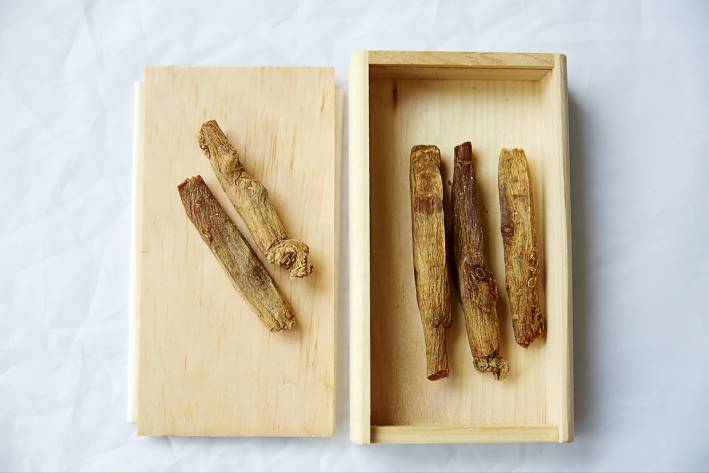I cannot think of ginseng without conjuring the image of Indiana Jones. Both are often found in the depths of the forest, both are brilliantly adaptive to all situations, both are constantly under attack, and both are powerful enough to survive and thrive. Both are exotic, mysterious, and dare I say, quite good looking—although one has been respected for over 5,000 years, and the other... not so long.
Ginseng is a plant with a root shaped like a human. In fact, the Chinese character for ginseng begins with the ideogram for human. It has also been called the man root, because ginseng harvesters think the root is man-shaped, and also because it is purported to be full of manly virtues. I don’t like this characterization as much, because ginseng is every bit as beneficial for women as for men.
One myth claims that there was a beautiful celestial woman who loved to descend to bathe in the pools in the Changbai mountains in Northeast Asia. Her father was not happy with his daughter’s mountain visits, especially when she fell in love with and married a mortal. Soon thereafter, a lethal epidemic threatened her home and village. She scattered magic seeds all through the forest, and the seeds sprouted into a plant that could cure everyone. Again, her father was displeased, and he imprisoned his daughter in a cave. Her beloved husband died of grief. Not exactly a happy ending to this fairy tale! I am not sure how many, if any, other herbs have this level of mythology, reverence, and history attached to their origin story.
Ginseng is incredibly powerful. It is also incredibly valuable, with large roots worth more than their weight in gold, even to this day. It is so valuable that Emperors of China have gifted jewels and honors to hunters finding unusually old specimens. At one point, all ginseng was reserved for use by the royal family, and commoners were not allowed access to this plant medicine.
Ginseng (Panax ginseng) originated in Asia and is in a class of herbs called adaptogens. Adaptogens boost an individual’s physical and psychological adaptability, creating strength to respond to dangers such as extreme heat, cold, viral infections, injuries, psychological stressors, and even aging itself.
Types of Ginseng
Panax ginseng is not American ginseng (Panax quinquefolius). They are cousins, but their health benefits differ. This article focuses on Panax (Asian) ginseng.
Red and White Ginseng
You may hear debate about white or red ginseng. While both forms come from the same plant, white ginseng is very minimally prepared, which means that it’s beneficial compounds, including ginsenosides, ginsans, and gintonins, are too bound up in the plant’s cell walls to be of much use.
Red ginseng, by contrast, is steamed, which breaks down some of the cell walls and gives the root powder a characteristic red/brown appearance. While all ginseng has some benefits, the majority of studies show that the steamed form, called red ginseng, is the most medicinally useful.
Benefits of Red Ginseng
-
Energy, Stamina, Focus
One area where red ginseng shines is in energy and stamina. It is not a stimulant like caffeine. Instead of acting as a stimulant, ginseng prevents fatigue in the first place. That means people can have a long-term boost without jitteriness. It also improves concentration.
A clinical study found that red ginseng helps stressed people do detailed tasks with better accuracy and speed. The people in this study worked in stressful jobs such as telephone communication, engineering, and information technology. People in these fields can become overloaded with cognitive tasks, leading to a drain of mental energy and focus. Because of that, attention and accuracy were two of the main areas of investigation of the study.
One group consumed a form of red ginseng with high levels of ginsenosides (HRG80) while the other used a placebo. Participants took either red ginseng or placebo in the morning. They were asked to do a tedious error-finding cognitive task before work and after work. The expectation was that after a hard day of multiple cognitive demands, individuals would make more errors.
That is exactly what happened in the placebo group. That group made 11 more errors in the task at the end of the day than in the beginning. But in the red ginseng group, participants actually performed better than when they were fresh in the morning. Even after a grueling day, they made an average of 5 less errors!
-
Response to Stress
Ginseng also strengthens our ability to withstand stress.
-
Mood
Depression, anxiety, even cognitive changes and memory impairment, are related to an unhealthy brain environment with excessive inflammation and oxidative stress. Red ginseng contains ginsenosides that are able to protect brain cells from these destructive forces. Research has found that red ginseng helps keep our brain (and subsequent mood) healthy by preventing the death of brain cells.
Ginseng’s activities include boosting nitric oxide production to keep blood flowing efficiently in both the body and brain, hormone signaling that is associated with clarity and focus, neural cell regeneration, and anti-inflammatory actions that reduce threats to vulnerable brain wiring.
A Korean human clinical study found that red ginseng significantly improved depression symptoms, including those physiological symptoms such as the physical slowdown that people suffering from depression so often feel.
-
Longevity
Traditional Chinese Medicine (TCM) doctors have always considered ginseng a longevity herb for both men and women, especially as they age. This has been borne out by modern science. Preliminary animal research has shown that daily use of ginseng can extend life by 14 percent or more. A human study of people with HIV-type 1 showed significant improvements in long term survival.
-
Women’s Health
There are studies on red ginseng and women’s health, including energy, focus, concentration, cancer, and menopausal symptoms, that have shown the safety and efficacy of this herb. One area of menopausal concern that responds well to red ginseng is mood.
Also, as women age, they may experience unwanted changes in sexual function and libido. Red ginseng (Panax ginseng) can help restore vigor, receptivity, desire, and enjoyment. There is growing research that shows it is extremely helpful for women with reduced libido.
Women in a placebo-controlled, double-blind clinical study reported that red ginseng significantly improved their sexual arousal and desire. The success of red ginseng was strong enough for researchers to consider that the herb may be used as an alternative to prescription medication for women to improve intimacy and libido.
Other clinical work showed that red ginseng also boosted a sense of well-being, reduced menopause symptoms, and increased arousal, orgasm, and overall sexual satisfaction as well.
-
Erectile Dysfunction (ED)
According to the National Institutes of Health (NIH), about 30 million American men deal with erectile dysfunction (ED), which is often related to circulatory issues that impede blood flow.
Scientific research on red ginseng shows that it can be very effective for ED. One double-blind, placebo-controlled study reported that men with mild to moderate ED noted a significant improvement on the Erectile Function Scale – from 16.4 to 21.0. The placebo group showed no improvement.
The researchers in this study also stated that ginsenosides may work through some of the same brain pathways and receptors as GABA, dopamine, and serotonin – brain neurotransmitters that are heavily involved in mood and desire.
Other clinical studies of red ginseng have demonstrated strong benefits, resulting in improvements in every parameter of sexual performance and a significant reduction of ED.
Red ginseng increases stamina, balances hormonal health, and promotes the dilation of blood vessels by activating nitric oxide – the body’s “on switch” which circulatory activity in the penis to achieve sexual satisfaction.
-
Cancer and Immunity
There are more than 1,400 published studies listed in the electronic database of the NIH, called PubMed, specifically on ginseng and cancer. Not only does ginseng help to prevent cancer by protecting the DNA inside our cells to keep it from dangerous mutations, it also helps people who have cancer or are recovering from cancer treatment. In addition to helping prevent/slow the spread of cancer, it helps enormously with cancer fatigue.
Likewise, there are over a hundred studies on ginseng and viral illness, including prevention, survival, and accelerated recovery. There are studies on hepatitis B, enterovirus respiratory tract infections, and much recent focus on its effectiveness in COVID-19. Ginseng has also been shown to be effective against many bacterial illnesses as well.
The Tragedy of Wild Ginseng
Humans have loved wild ginseng almost to death.
The demand for ginseng has eliminated most of the wildcrafted sources, and now it is grown on farms, many of which are in Northern China and Korea. Unfortunately, farmed ginseng has many challenges, as the cultivated plant is sensitive to weed competition and a variety of insects.
In order to assure a commercially successful crop, a wide variety of herbicides, pesticides, and fungicides are used on farmed ginseng crops. An article published in Horitcultural Science lists 15 chemicals applied at different stages of the growing process to control such pests as cutworms, slugs, nematodes, gray mold, and root rot.
Also, ginseng plant cultivation takes a long time – about six years between harvests to produce even a minimally effective ginseng. Slow growth allows time for the roots to absorb toxins and pollutants in the soil. Red ginseng has become notorious for contamination with toxins.
Good News: Hydroponics
Because of these concerns, new ways to grow ginseng have been investigated and developed. Researchers in Belgium are using novel hydroculture growing techniques that result in a much cleaner, more powerful ginseng.
Researchers have recently learned that specific compounds in ginseng, called noble ginsenosides, are not only better absorbed by the body, but have specialized, energizing effects. Noble ginsenosides are found in small amounts in ginseng. One of the problems with modern ginseng cultivation is that it robs the plant of its levels of noble ginsenosides, too. They just aren’t present at levels that may have been the norm for wild ginseng.
Also, there are no benefits from ginsenosides if they cannot be absorbed. Noble ginsenosides are the smaller, easier to absorb, more effective, and most rare of the beneficial compounds from ginseng. They are 17 times easier to absorb.
Whole Root Red Ginseng
While there are commercial red ginseng extracts that focus only on ginsenosides, whole root red ginseng powder offers a high concentration of noble ginsenosides plus synergistic compounds including gintonin and ginsan.
Whole root powder means the full spectrum of ginseng compounds are present, and have superior benefits.
Ginseng for... Everything?
Because red ginseng works in ways that impact nearly all bodily systems, it can be used for the vast majority of health concerns and illnesses. It would be difficult to find a health problem for which red ginseng would not be useful!


